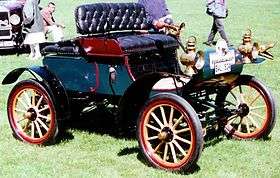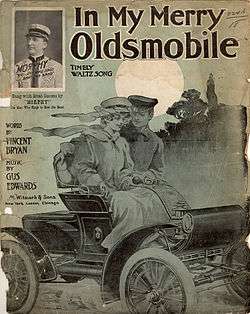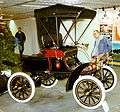Oldsmobile Curved Dash
| Oldsmobile Runabout | |
|---|---|
 | |
| Overview | |
| Manufacturer | Oldsmobile |
| Also called | Model 6 |
| Production |
1901–1907 About 19000 built |
| Assembly | Detroit, MI[1] |
| Body and chassis | |
| Class | Entry-level car |
| Body style | Runabout |
| Powertrain | |
| Engine | 95 cu in (1,560 cc) horizontal one-cylinder[2] |
| Transmission | Planetary 2-speed |
| Chronology | |
| Successor | Oldsmobile Model 20 |

The gasoline-powered Curved Dash Oldsmobile is credited as being the first mass-produced automobile, meaning that it was built on an assembly line using interchangeable parts. It was introduced by the Oldsmobile company in 1901 and produced through 1907. 425 were produced the first year,[3] 2,500 in 1902, with over 19,000 built in all.[4] When General Motors assumed operations from Ransom E. Olds on November 12, 1908,[5] GM introduced the Oldsmobile Model 20, which was the 1908 Buick Model 10 with a stretched wheelbase and minor exterior changes.[6]
It was a runabout model, could seat two passengers, and sold for US$650. While competitive, due to high volume, and priced below the US$850 2-seat Ford Model C "Doctor's Car"[7], it was more expensive than the Western 1905 Gale Model A roadster at US$500. The Black sold for $375,[8] and the Success for US$250.[9]
The flat-mounted water-cooled single-cylinder engine, situated at the center of the car, produced 5 hp (3.7 kW),[2] relying on a brass gravity feed carburetor. The transmission was a semi-automatic design with two forward speeds and one reverse. The low-speed forward and reverse gear system are a planetary type (epicyclic). The car weighed 850 lb (390 kg) and used Concord springs. It had a top speed of 20 mph (32 km/h).[10]
The car’s success was partially by accident — in 1901 a fire destroyed a number of other models before they were approved for production, leaving the Curved Dash the only one intact.[11]
Gallery
 1903 Model R Runabout
1903 Model R Runabout 1904 Model 6C Runabout
1904 Model 6C Runabout 1904 Model 6C Runabout with top up
1904 Model 6C Runabout with top up 1905 Model B Runabout
1905 Model B Runabout 1903 advertisement
1903 advertisement
Notes
- ↑ Location of Curved Dash factory
- 1 2 Rogliatti 1973, pp. 270–271.
- ↑ Posthumus 1977, p. 48.
- ↑ Georgano 1985, p.
- ↑ Oldsmobile Joins GM
- ↑ 1908 Oldsmobile Model 20 introduction
- ↑ Clymer 1950, p. 37.
- ↑ Clymer 1950, p. 61.
- ↑ Clymer 1950, p. 32.
- ↑ Sedgwick 1962, p. 36.
- ↑ Wright 2000.
References
- Clymer, Floyd (1950). Treasury of Early American Automobiles, 1877-1925. New York, NY US: Bonanza Books.
- Frank Leslie's Popular Monthly (January, 1904)
- Georgano, G. N. (1985). Cars: Early and Vintage, 1886-1930. London, UK: Grange-Universal.
- Posthumus, Cyril (1977) [1977]. "The Motoring Boom". The story of Veteran & Vintage Cars. John Wood, illustrator (Phoebus 1977 ed.). London: Hamlyn / Phoebus. pp. 36–49. ISBN 0-600-39155-8.
The 1901 output was 425 cars, and this figure rose to 2100 in 1902, 3750 in 1903, and 5000 in 1904.
- Rogliatti, Gianni (1973). Posthumus, Cyril, ed. Period Cars. Feltham, Middlesex, UK: Hamlyn. ISBN 0-600-33401-5.
- Sedgwick, Michael (1962). Early Cars. Putnam.
- Wright, Richard A. (2000-03-08). "detnews.com | Michigan History". Apps.detnews.com. Archived from the original on 2013-03-28. Retrieved 2009-06-27.
External links
| Wikimedia Commons has media related to Oldsmobile Curved Dash. |
- Oldsmobile Club of America
- 1905 Oldsmobile Image (Suffolk County(NY) Historical Society Museum)
- Soule, Gardner (December 1951). Torrey, Volta, ed. "From Coast To Coast In An Old Old Olds". Popular Science. New York, NY US: Popular Science Publishing. 159 (6): 129–132, 258. – large 1951 article on a 1904 Olds making a coast to coast trip with detailed photo of subject
